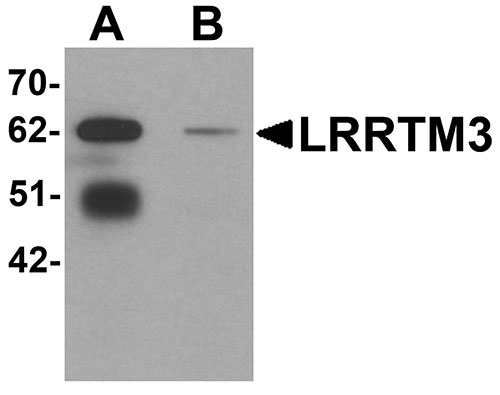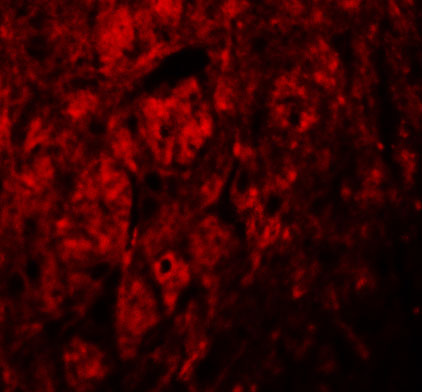LRRTM3 Antibody
- SPECIFICATION
- CITATIONS
- PROTOCOLS
- BACKGROUND

Application
| WB, IHC-P, IF, E |
|---|---|
| Primary Accession | Q86VH5 |
| Other Accession | NP_821079, 109809759 |
| Reactivity | Human, Mouse, Rat |
| Host | Rabbit |
| Clonality | Polyclonal |
| Isotype | IgG |
| Calculated MW | 65896 Da |
| Application Notes | LRRTM3 antibody can be used for detection of LRRTM3 by Western blot at 0.5 µg/mL. Antibody can also be used for immunohistochemistry starting at 2.5 µg/mL. For immunofluorescence start at 20 µg/mL. |
| Gene ID | 347731 |
|---|---|
| Target/Specificity | LRRTM3; At least two isoforms of LRRTM3 are known to exist; this antibody will only detect the larger isoform. |
| Reconstitution & Storage | LRRTM3 antibody can be stored at 4℃ for three months and -20℃, stable for up to one year. As with all antibodies care should be taken to avoid repeated freeze thaw cycles. Antibodies should not be exposed to prolonged high temperatures. |
| Precautions | LRRTM3 Antibody is for research use only and not for use in diagnostic or therapeutic procedures. |
| Name | LRRTM3 |
|---|---|
| Function | Exhibits a limited synaptogenic activity in vitro, restricted to excitatory presynaptic differentiation (By similarity). May play a role in the development and maintenance of the vertebrate nervous system. |
| Cellular Location | Cell membrane; Single-pass type I membrane protein. Postsynaptic cell membrane; Single-pass type I membrane protein |
| Tissue Location | Expressed in neuronal tissues. |

Thousands of laboratories across the world have published research that depended on the performance of antibodies from Abcepta to advance their research. Check out links to articles that cite our products in major peer-reviewed journals, organized by research category.
info@abcepta.com, and receive a free "I Love Antibodies" mug.
Provided below are standard protocols that you may find useful for product applications.
Background
LRRTM3 Antibody: The Leucine-rich repeat transmembrane neuronal proteins (LRRTMs) are differentially expressed in the nervous system and were recently found to instruct presynaptic and mediate postsynaptic glutamatergic differentiation, with LRRTM1 and LRRTM2 most potent at inducing presynaptic differentiation. Recent evidence suggests that LRRTM3 promotes the processing of amyloid-precursor protein (APP) by the beta-secretase BACE, leading to the proteolytic production of the Abeta42 peptide that is the main component of amyloid plaques. Furthermore, LRRTM3 maps to a region of chromosome 10 linked to both late-onset Alzheimer's disease (AD) and elevated plasma Abeta42 levels, suggesting that LRRTM3 is a functional and positional candidate gene for AD.
References
Lauren J, Airaksinen MS, Saarma M, et al. A novel gene family encoding leucine-rich repeat transmembrane protein differentially expressed in the nervous system. Genomics 2003; 81:411-21.
Linhoff MW, Lauren J, Cassidy RM, et al. An unbiased expression screen for synaptogenic proteins identifies the LRRTM protein family as synaptic organizers. Neuron 2009; 61:734-49.
Siddiqui TJ, Pancaroglu R, Kang Y, et al. LRRTMs and neuroligins bind neurexins with a differential code to cooperate in glutamate synapse development. J. Neurosci. 2010; 30:7495-506.
Majercak J, Ray WJ, Espeseth A, et al. LRRTM3 promotes processing of amyloid-precursor protein by BACE1 and is a positional candidate gene for late-onset Alzheimer’s disease. Proc. Natl. Acad. Sci. USA 2006; 47:17967-72.
If you have used an Abcepta product and would like to share how it has performed, please click on the "Submit Review" button and provide the requested information. Our staff will examine and post your review and contact you if needed.
If you have any additional inquiries please email technical services at tech@abcepta.com.













 Foundational characteristics of cancer include proliferation, angiogenesis, migration, evasion of apoptosis, and cellular immortality. Find key markers for these cellular processes and antibodies to detect them.
Foundational characteristics of cancer include proliferation, angiogenesis, migration, evasion of apoptosis, and cellular immortality. Find key markers for these cellular processes and antibodies to detect them. The SUMOplot™ Analysis Program predicts and scores sumoylation sites in your protein. SUMOylation is a post-translational modification involved in various cellular processes, such as nuclear-cytosolic transport, transcriptional regulation, apoptosis, protein stability, response to stress, and progression through the cell cycle.
The SUMOplot™ Analysis Program predicts and scores sumoylation sites in your protein. SUMOylation is a post-translational modification involved in various cellular processes, such as nuclear-cytosolic transport, transcriptional regulation, apoptosis, protein stability, response to stress, and progression through the cell cycle. The Autophagy Receptor Motif Plotter predicts and scores autophagy receptor binding sites in your protein. Identifying proteins connected to this pathway is critical to understanding the role of autophagy in physiological as well as pathological processes such as development, differentiation, neurodegenerative diseases, stress, infection, and cancer.
The Autophagy Receptor Motif Plotter predicts and scores autophagy receptor binding sites in your protein. Identifying proteins connected to this pathway is critical to understanding the role of autophagy in physiological as well as pathological processes such as development, differentiation, neurodegenerative diseases, stress, infection, and cancer.




